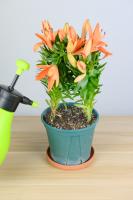Introduction
Spraying water on plant leaves is a common gardening practice. Some gardeners argue that it helps plants grow better, while others believe it can do more harm than good. In this article, we'll explore the benefits and drawbacks of spraying plant leaves with water.
The Benefits of Spraying Plant Leaves with Water
One of the benefits of spraying water on plant leaves is that it helps increase humidity around the plants. This is particularly important in hot and dry climates, where plants can easily become dehydrated. When the humidity around the plants is increased, they can better retain their moisture and be less likely to wilt or dry out.
Another benefit of spraying water on plant leaves is that it can help rinse off any dust or debris that may have accumulated on them. This can help the leaves better absorb sunlight and the nutrients they need to grow. Additionally, removing dust and debris can help prevent pest infestations.
Spraying water on plant leaves can also help cool them down during hot weather. When the water evaporates from the leaves, it creates a cooling effect that can help keep the plants from overheating.
The Drawbacks of Spraying Plant Leaves with Water
Although spraying water on plant leaves can have some benefits, it can also have drawbacks. One of the main drawbacks is that it can encourage the growth of fungal diseases on the leaves. This is especially true if the water sits on the leaves for an extended period of time without evaporating. Fungi thrive in moist environments, so allowing water to linger on plant leaves can create a breeding ground for them.
Another drawback of spraying water on plant leaves is that it can damage the leaves if it's done at the wrong time of day. If the water is sprayed on the leaves during the hottest part of the day, the sun can magnify the water droplets and burn the leaves. This can result in unsightly brown spots on the leaves and reduce the plant's ability to photosynthesize.
Finally, spraying water on plant leaves can also waste water if it's done excessively or without intention. If the water is not targeted at specific plants or areas, it can end up being wasted and not providing any benefit to the plants.
When to Spray Plant Leaves with Water
If you do decide to spray water on your plant leaves, it's important to do it at the right time of day. The best time to spray water on plant leaves is early in the morning or in the late afternoon when the sun is not as strong. This will prevent the water from evaporating too quickly and causing damage to the leaves.
Additionally, it's important to make sure that the water is not sitting on the leaves for an extended period of time. Try to use a spray nozzle that emits a fine mist, rather than a strong stream of water. This will help distribute the water evenly across the leaves and prevent too much water from accumulating in one spot.
Conclusion
In conclusion, spraying water on plant leaves can have both benefits and drawbacks. It can help increase humidity, rinse off dust and debris, and cool down the plants. However, it can also encourage fungal growth, damage the leaves if done at the wrong time, and waste water if not targeted properly. If you do decide to spray water on your plant leaves, make sure to do it in the early morning or late afternoon and use a fine mist to distribute the water evenly.

 how many times do yo...
how many times do yo... how many planted tre...
how many planted tre... how many pine trees ...
how many pine trees ... how many pecan trees...
how many pecan trees... how many plants comp...
how many plants comp... how many plants can ...
how many plants can ... how many plants and ...
how many plants and ... how many pepper plan...
how many pepper plan...





























